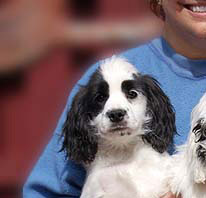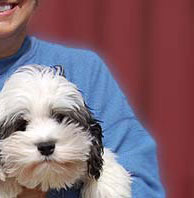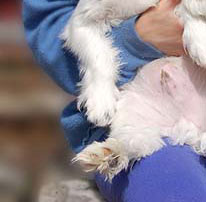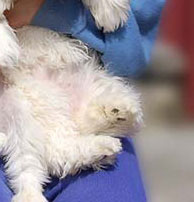|
|
| Introduction - | |
| A true Cockapoo is 50% (American) Cocker Spaniel and 50% Poodle. That is a Cockapoo... half Poodle, half Cocker, looking like neither a Poodle nor a Cocker but truly a combination of both. There are some Cockapoos which have curlier coats and longer, more Poodle-like muzzles, and others which have more Cocker Spaniel-looking bodies and faces/ears. Why? There are many reasons, but the most prominent of them are:
|
All puppies are cute, and 95% or more of buyers wouldn't begin to know what a Cockapoo puppy is supposed to look like. It is very easy to pass off any mixed-breed puppy as a "Cockapoo" (or "Labradoodle" or "Goldendoodle"), and this is, unfortunately, done all the time. I have been raising Cockapoos since 1997. My partner, Rob, has raised Cockapoos for almost 20 years. We have discussed this issue at length and have come to the same conclusion: All 1st-Generation Cockapoos that we have raised have grown up to look like a Cockapoo should; not like a Poodle and not like a Cocker Spaniel. It didn't matter which parent was the Cocker Spaniel and which was the Poodle. It didn't matter if one particular Poodle (for example, Jagger) produced young puppies with less facial hair and curls. The puppies all grew up to have all the facial hair (full beard and mustache) and body coat (waves and/or soft curls) which would proclaim that one parent was a Poodle. |
|||||
| In all this I have been discussing only first-generation Cockapoos. With second-generation Cockapoos, two hybrid parents are bred (both with 50% Poodle- and 50% Cocker Spaniel-trait genes). Some second-generation Cockapoos can, and do, look more like Cocker Spaniels or like Poodles (see above picture.) It is only by using the best (most Cockapoo-like) 2nd-generation dogs to breed and produce 3rd (and further) generations that Cockapoo litters will become standardized, and eventually there will be no "surprises" in a litter of Cockapoos. | |||||
| Sizes and Variations of Cockapoos - | |||||
| Cockapoo sizes are gauged according to the three recognized sizes of Poodles (i.e., toy, mini and standard). For sake of reference, toy-sized adults are 10" tall (or less) at the shoulder, mini-sized adults are 11" to 14" tall, and standard-sized adults are 15" and taller. As with the Poodle breed, there are many variations in size with Cockapoos. Two mini Poodles can be bred and (in the same litter) produce offspring ranging from tiny toys to minis, small and large. One of my poodles, Lambchop, produced a litter of six puppies: One is toy-sized, four are mini-sized, and one is standard-sized. Lambchop is a fairly large mini-sized poodle, and the sire Poodle is a small mini. The difference in size between the smallest pup (a male) and the largest pup (also a male) is absolutely incredible. All pups were the same size at birth. No pup lacked nourishment of any kind at any time. I have discussed Poodles and size differences because 1st-generation Cockapoos are half Poodle. The "size genes" which are expressed in a litter of Cockapoo puppies (contributed by both the Cocker Spaniel parent and the Poodle parent) can also vary from one pup to another. There can be some pups in a litter who will, perhaps, inherit the genes for toy size, whereas others could inherit the mini-size genes. The pups with the smallest bone structure (which many times are the tiniest puppies in the litter) may not be "runts" at all, but truly stay much smaller than their siblings. As with purebred dogs (and all forms of life), all puppies are programmed genetically to be a certain size. Given proper food and care after weaning, the tiniest pup will eventually reach its potential, the size it was meant to be. An example of this is my Cockapoo, Kiepre. She is 11" tall at the shoulder and weighs approximately 12 lbs. All of her siblings are nearly twice her size. Although it is true that Kiepre was born not breathing, once she started breathing normally on her own, she never had a problem nursing, and until about a month old was exactly the same size as her littermates. There are both small cockers and toy poodles in Kiepre's pedigree. She inherited those genes. |
|||||
| Variations on Cockapoo characteristics (such as size and/or coat texture) are typically made either by very careful research of the parental Cockapoos' pedigrees prior to breeding or by breeding a Cockapoo back with an unrelated "ancestral" purebred (i.e., Cocker Spaniel or Poodle). Producing toy-sized Cockapoos in first generation, for example, is not an easy task. The breeder must have an (American) Cocker Spaniel who is small and/or known to come from small stock going back at least a few generations. The Poodle parent should be tiny toy-sized* (see Note), and the breeder should be able to trace the pedigree back and see only toy poodles in several generations. If two unrelated toy Cockapoos with tiny toy Poodles and small Cocker Spaniels in their lines are bred to each other, the resulting litter would have a much greater likelihood of producing toy Cockapoos than breeding a Cocker to a Poodle (no matter how small the Poodle) or arbitrarily breeding just any two Cockapoos to each other without researching the sizes of the grandparent and great grandparent dogs on "both sides of the equation". "Back-breeding" of a Cockapoo to an unrelated "ancestral" purebred is a far more complicated way of trying to modify physical characteristics of the offspring produced. Consider, for example, a Cockapoo bred to a Poodle. A "full" Poodle is a purebred dog: It has only Poodle genes. A Cockapoo has both Poodle and Cocker Spaniel genes. By breeding a Cockapoo to a pure Poodle, there is absolutely no way to produce puppies which will be 50% Cocker and 50% Poodle. If the Cockapoo contributed as many Cocker Spaniel traits/genetic material as would be possible, the resulting puppies would exhibit, in a best-case scenerio, 25% Cocker and 75% Poodle characteristics. These puppies would unquestionably be curlier, and could/would be easily mistaken for pure Poodles. That would be a "best"-case scenario. In a worst-case scenario, the Cockapoo would contribute more of the Poodle-trait genes, and the resulting pup(s) would be even more Poodle-like, with little or no Cocker Spaniel traits in them at all. There would, however, be possibilities for differences in size (as discussed above). Regardless, Cockapoos bred to Poodles do not produce Cockapoos: Most breeders call the resulting pups "cockapoo-poos". The pups are adorable, and it is a way of potentially producing toy-sized Cockapoos, but the puppies really are more Poodle than Cockapoo. (*Note: there are no "teacup" toy Poodles recognized by the AKC or Poodle clubs. Any Poodle 10" or less at the shoulder, no matter what its weight, is considered a toy Poodle.) |
|||||
| Conclusion - | |||||
| Unless potential dog buyers are knowledgeable enough to look at a Cockapoo litter that is 2nd generation or further and know which key characteristics should be evident to differentiate the "true Cockapoos" from the "part Cockapoos", I recommend they stick with 1st-generation Cockapoos for pets. Nowadays, many potential buyers looking for a family pet research the Internet, look at hundreds of websites and countless pictures, ask detailed questions, and thus have a better chance of getting what they are paying for. Breeders buying or raising stock to breed Cockapoo to Cockapoo had better know a lot more about genetics and Cockapoos than the average buyer. |



